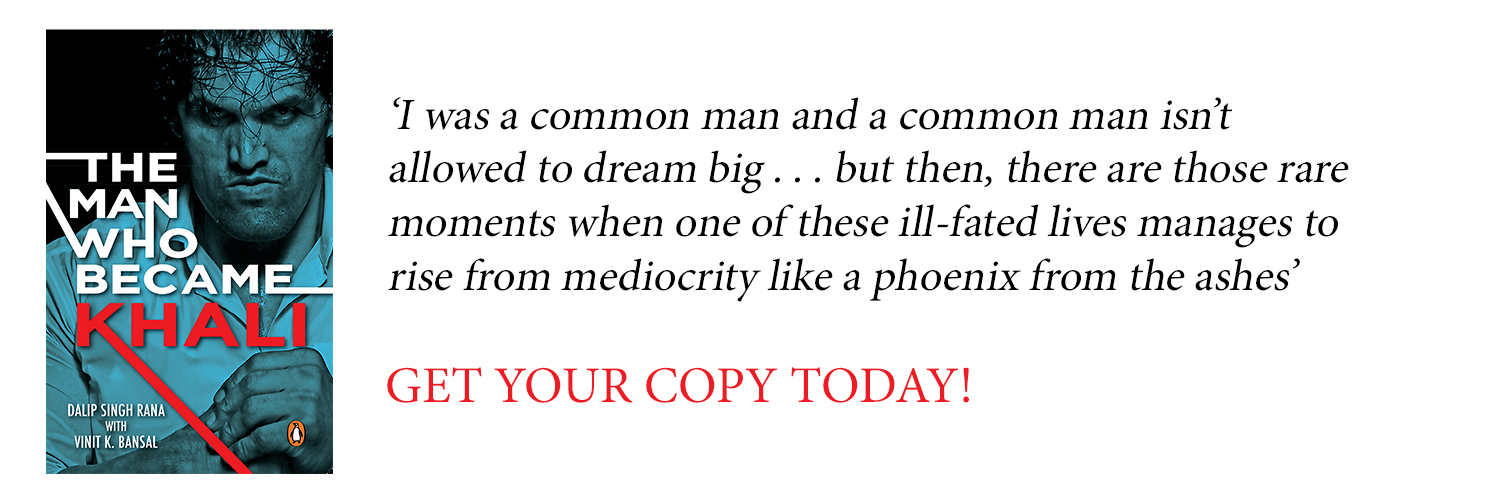Uttar Pradesh or U.P. has some really colourful vibe to it. Not only is this vibrant state famous for its amazing food and culture, the Hindi spoken in the state is also rife with some amazing kahawats. These kahawats not only add spice to the Hindi people speak in the state, but also pass on some precious wisdom in the wittiest way.
Here are some kahawats to enrich your life:






Know some more of such amazing kahawats? Tell us in the comments.

Tag: Penguin India
10 Delightful Quotes that will Dazzle Your Day
“I’d rather people read my book twice than only half-way through,” Mohsin Hamid replied once when asked about his compelling and minimalist prose. It’s this splendid literary ambition that seals the position of Mohsin Hamid among the most brilliant writers of our time.
Here are ten exemplary quotes from his books that will leave you awe-struck!










Dazzled for the day? Grab your copy of Mohsin Hamid’s latest novel – Exit West – here and soak in the magic of his storytelling.
9 Things You Didn’t Know About the Pakistani Army
The military is one of the vital organs of the state. However, in Pakistan, the military plays a far more deep-rooted role in the politics of the country, and dominates all other institutions.
Ayesha Siddiqa, in her extensively-researched book, Military Inc. aims to explain the role of personal economic stakes in commercial ventures as a driver of the armed forces’ political ambitions.
Pakistan’s military runs a huge commercial empire. Here are nine facts that will give you a glimpse of the military’s involvement in the various institutions of the country:









Find out more about the army’s involvement in Pakistan’s economy in Ayesha Siddiqa’s Military Inc.

What Aurangzeb Loved: 6 Things that Moved His Heart
Aurangzeb was an enigmatic king. To quote Khafi Khan, the laudatory eighteenth-century historian of Aurangzeb’s reign, who, comparing Aurangzeb to the Persian ruler Jamshid said, “To attempt a summary of the major events of a fifty-year reign of an emperor the equal of Jamshid is to measure the ocean’s water with a pitcher.”
There were many layers to Aurangzeb, many things that inspired and moved his heart.
Here are six instances from Aurangzeb’s life that reveal his loves and passions!
He had a passion to carry the Mughal legacy forward and building a great career

He had a deep love for literature and poetry

Few know about Aurangzeb’s whirlwind romance

Leisure and music moved his heart

He had a passion for justice

And he loved mangoes!


Fascinated? Looking to read more about this Indian emperor who is often misunderstood? Get Audrey Truschke’s Aurangzeb: The Man and the Myth here!
How Tata Tea and Apple Came To Be — An Excerpt
Steve Jobs created Apple, one of the most successful brands on this planet. Apple is remarkable because it has married design and technology marvelously, time and again, generating sensuous products that millions of human beings across the world lust for. Jobs himself attributes a good part of this Apple magic to his curiosity.
In his famous commencement speech delivered at Stanford University in 2005, he gave an example of how, during his student days, he decided to take a calligraphy class at Reed College out of sheer curiosity. He said he learnt about serif and sans serif typefaces in this class, about varying the space between different letter combinations, about what makes great typography truly great. He called this learning experience beautiful, historical and artistically subtle in a way that science cannot quite capture.
He went on to say, ‘None of this had even a hope of any practical application in my life. But ten years later, when we were designing the first Apple Macintosh computer, it all came back to me. And we designed it all into the Mac. It was the first computer with beautiful typography. If I had never dropped in on that single course in college, the Mac would have never had multiple typefaces or proportionally spaced fonts. And since Windows just copied the Mac, it’s likely that no personal computer would have them.’ He added, ‘Much of what I stumbled into by following my curiosity and intuition turned out to be priceless later on.’ The sheer beauty of Apple products, which is a huge contributor to the brand’s success, owes something to its creator’s curiosity.
Just like Apple, so many great brands have their roots in the curiosity of marketers. Consider Tata Tea, the leading brand of tea in India today. This brand was born out of the curiosity of Darbari Seth, who was chairman of several Tata companies in the mid-1980s. He wondered why tea could not be packaged in an airtight polythene pillow pack (polypack), rather than in the cardboard cartons that were the norm at that time. His visits to various Indian towns had shown that consumers were very happy with these flat pillow packs for another commonly used kitchen product: salt. Seth had, a few years earlier, already launched the popular Tata Salt brand.
In addition, his own explorations into two very different spaces gave rise to some thoughts that he could toss around. From his numerous informal conversations with traders during the early days of Tata Salt, he had learnt that the strong smell of spices permeates all Indian kirana stores, which, in turn, taints various products stocked in these stores, including tea. Seth’s explorations into the world of science—he spent many decades working as a chemical engineer—had left in his mind the clear impression that polypacks made from a laminate of polythene and polyester would be significantly better than cardboard cartons, ensuring tea leaves were safe from these strong spice smells. So, driven by these curiosity inspired reflections, he went ahead and launched Tata Tea in laminate polypacks in 1987. This kept the plantation-packed tea fresh and untainted, and the brand went on to become a huge success.
I had the good fortune of working as a junior member of Seth’s team in Tata Tea during those years, and have seen at close quarters how curious he was by nature. I would accompany him on his visits to London, and I was often dumbfounded by the sheer number of questions he would ask me on just about everything. He inspired the creation of two of India’s strongest consumer brands—Tata Salt and Tata Tea. Interestingly, quite similar to how Microsoft copied the amazing typography of the Apple Macintosh, hundreds of other Indian tea brands have copied Tata Tea’s winning polypack. You will find them available across the country today.

5 Books You Should Read This Spring
Spring is the best season of all. With the flora at full bloom, you just want to stop and admire the beautiful scenes. Not only does spring signify beauty but it also signifies transition. So, what better way to enjoy the season than reading outdoors while basking in the sunlight.
Here’s a list of 5 books you should read this spring:
Anne of Green Gables
Mathew and Mariila Cuthbert were expecting a boy to show up from the orphanage. Little did they know, they will have the dreamy, talkative Anne to take care of their Green Gables. The descriptions of sights of Avonlea and Green Gables are so vivid that it makes you fall in love with nature even more.

Leaves of Grass
Strewn with vivid description of nature, Walt Whitman in this poetry collection professes his love for the universal elements, flora and the fauna. After reading the poems, we also cannot help but awe at the marvels of nature.
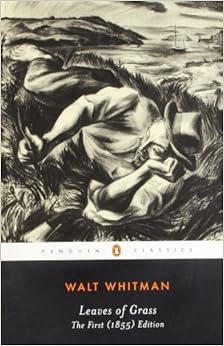
Heidi
This little girl was sent to live with her grandfather in the mountains. With each passing day, she grew to be fonder of the scenic beauty. But when she was sent to live in the city, even Clara’s friendship couldn’t make her miss the mountains any less. Honestly, even we wouldn’t have coped to live in the city after living amidst such beauty.

Catcher in the Rye
The protagonist of this story is standing at the brink of adulthood and is yet apprehensive to make the transition. He wants to own a rye field at the edge of a cliff where thousands of children play. He would then catch them if they come close to falling from the cliff. He just wants to be a savior of innocence when he is in the process of losing his.

The Room on the Roof
In a sleepy town of Dehradun, our boy Rusty flees from his house to live with his friends. Enamored by the beauty of his town, Indian customs, festivals and foods. He understands that his life will not be as hunky dory as he thought but he still does not give up on his pursuit of a happier life.
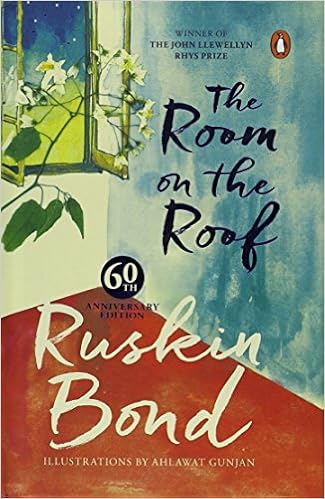
Can you think of any more books that depict change and nature’s beauty with equal panache? Tell us.
5 Things You Didn’t Know About Mohammad Ali Jinnah
Mohammad Ali Jinnah is well known as a world leader who rose during the freedom struggle against British colonization. Personally, he was often described as stern or cold and singularly obsessed with his political ambitions, however , there are many unknown facets to him.
Sheela Reddy uncovers some of these in her new book, Mr and Mrs Jinnah:





Sheela Reddy in her exhaustive account, chronicles the unknown facets of the man known as Mohammad Ali Jinnah. Get your copy here.
Bill Gates: A Senior Executive Who Goes Where the Action is
There are three important questions I think every person, and certainly every manager, should ask himself or herself about how well they listen: The first: Do you get out from behind your desk and walk the corridors and floors?
To know what is going on, you have to be where the action is. You have to go to your customers. You have to go to the factory, or to the sales floor, or to where the problems are.
To me, Bill and Melinda Gates offer one of the best examples of senior executives going where the action is. Many nonprofit organizations with budgetary concerns do not deliver a high percentage of their income directly to the cause they serve. Thirty percent or more of the money they raise goes to operating costs. In other words, for every dollar you donate to such organizations, the intended audience gets at best 70 cents. The Gates Foundation, on the other hand, does devote a high percentage of its income to helping those in need. One reason is that both Bill and his wife, Melinda, are frequent visitors to the countries in which their foundation is active.
Here is how Bill Gates described their first trip to Africa:
“It was a phenomenal trip. Not long after we returned from this trip, Melinda and I read that millions of poor children in Africa were dying every year from diseases that nobody dies from in the United States: measles, hepatitis B, yellow fever. Rotavirus, a disease I had never even heard of, was killing half a million kids each year. We thought if millions of children were dying, there would be a massive worldwide effort to save them. But we were wrong.”
The Gates Foundation then set up a system to guarantee purchases from drug companies to combat the diseases. Bill Gates concluded, “There’s actually no substitute for going and seeing what is happening.”
The second question to ask yourself about how well you listen: Am I doing most or all of the talking in my interactions with others? Listening is an educational process. When you don’t listen, you don’t learn. Marshall Goldsmith, a well- known executive coach and a good friend, advises people who have a hard time listening to do the following: stop, take a deep breath— and let the other person speak up.
The third question to ask yourself about your ability to listen: Do I try to empathize with other people?
Being empathetic is the second step in being thoughtful. Empathy requires that you attempt to identify with the feelings, thoughts, or attitudes of another person. There are four aspects to empathy. The first is understanding that one person cannot do everything. When you empathize with someone it doesn’t matter who the other person is or what he or she does. I know that every person I interact with is valuable and is deserving of empathy.
The second aspect of empathy that I see around us too much is me, me, and me. We must transform me, me, and me to you, you, and you. We must make sure that everything in our lives is not about me; it must be about someone else.
The third aspect of empathy that deserves attention is our acceptance that each of us is but a very tiny speck in the universe. I am very fortunate that the back of my house overlooks the Pacific Ocean. When I do nothing but look out at the ocean, I sense how small I am. I am known in my field and to my friends and associates as an energetic person. But when I stare out at the Pacific, I am humbled. However, I am also inspired. That sense of my smallness in the world is what gives me energy. It causes me to question myself, and accept that I am not good enough, that I am not contributing enough. I am not making enough impact. I’m not adding enough value to the world around me. My sense of humility does not come from thinking about how important I am, but from how small and insignificant I am compared to the endless expanse of the universe. And ultimately, I believe, our humility is what defines us and makes us selfless.
I find that I often learn some of my most important lessons from children. So I asked a schoolchild what empathy meant to him. I knew that he had just completed a school project about it. Here is what he said. “If somebody fell at our school while we are playing together, even if we are all enjoying the game, if someone goes to try to help out, to take care of the kid, or maybe go get the nurse, I think that is empathy.” To me, that is a perfect description of a caring mindset. He thought of empathy as “kindness.” And that is the fourth aspect of empathy that I want to focus on. Kindness is an action. It is the doing part of empathy. I try to practice it in my work every day.
This is an excerpt taken from ‘The Difference: When Good isn’t Enough’ by Subir Chowdhury.

7 Quotes that Sum up the Brilliance of Chanakya’s Wisdom
Chanakya was one of the best strategic thinkers the world has ever seen. In the fourth century BC, he wrote the Arthashastra, an unrivalled political treatise that has since been used by leaders across the globe.
In Inside Chanakya’s Mind, Radhakrishnan Pillai, the best-selling author of Corporate Chanakya, takes us deep into the teachings and philosophy of Chanakya. He will guide readers through Kautilya’s art of thinking through his very practical and innovative approach.
Here are a couple of quotes from the book that highlights the brilliance of Chanakya’s mind.







—-
7 Quotes by The Great Khali that’re Bound to Motivate You
The world knows him as the WWE superstar, but most do not know the entire story of Dalip Rana. Born in a small village, his formative years were nothing if not full of turbulence. From leaving his school to working as a daily-wage labourer to bodybuilding, he had done it all at a very young age. Often the subject of ridicule, he was poked fun at due to his extraordinary size. However, a determined Dalip relentlessly pursued his goal of wrestling and such was his passion that he did what no Indian had done so far enter the internationally acclaimed WWE arena!
The Man Who Became Khali is an inspirational, emotional and a no-holds-barred account of a man who not only went on to win the World Heavyweight Championship but also conquered his inner demons and physical anomalies.
This is the story of how Dalip Singh Rana became the international icon – The Great Khali!
He’s lived a hard life and fought hard to become a winner. And that is why there is no one better to motivate us. Enjoy some of the most inspirational quotes from The Man Who Became Khali, written by Dalip Singh Rana and Vinit K Bansal.
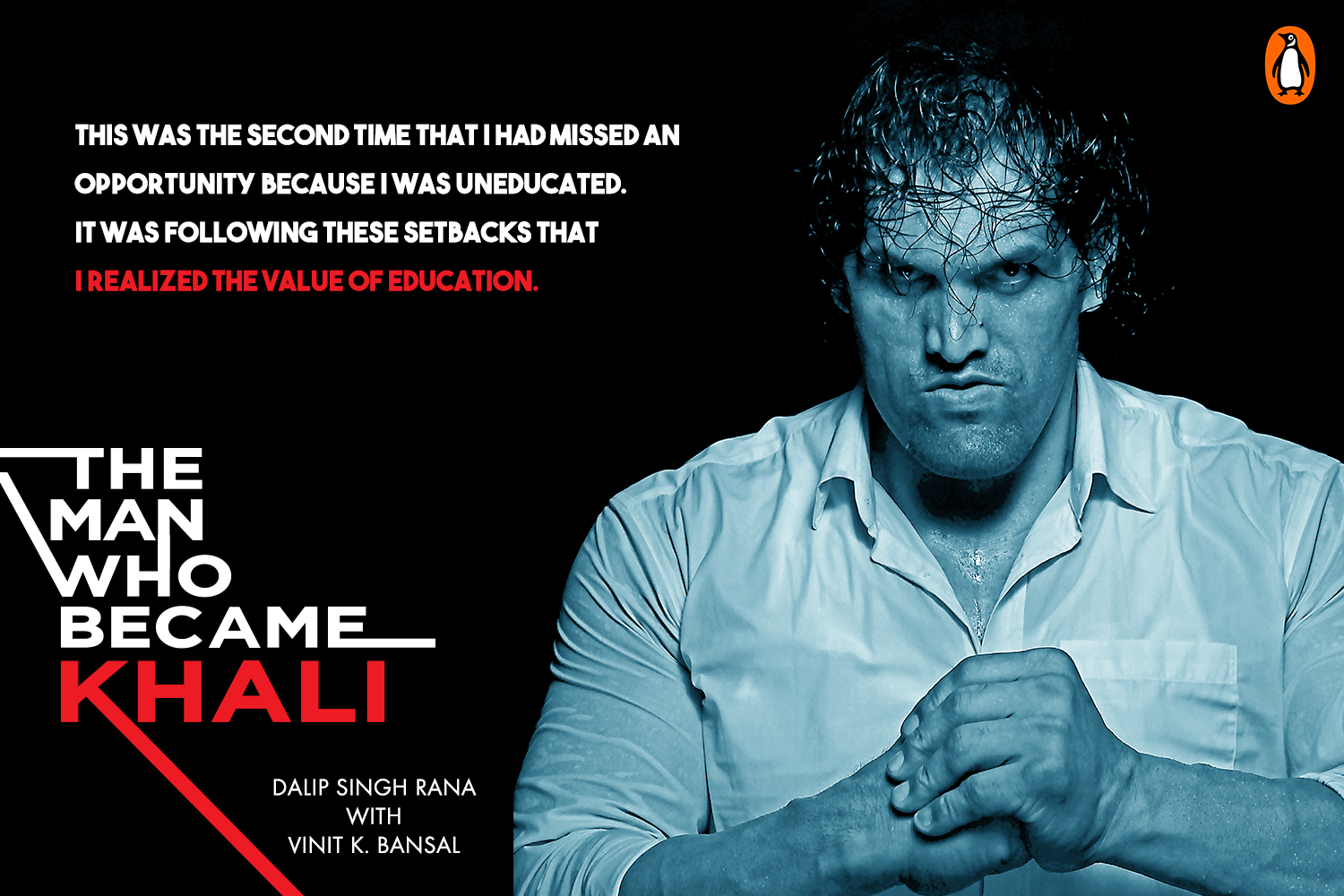

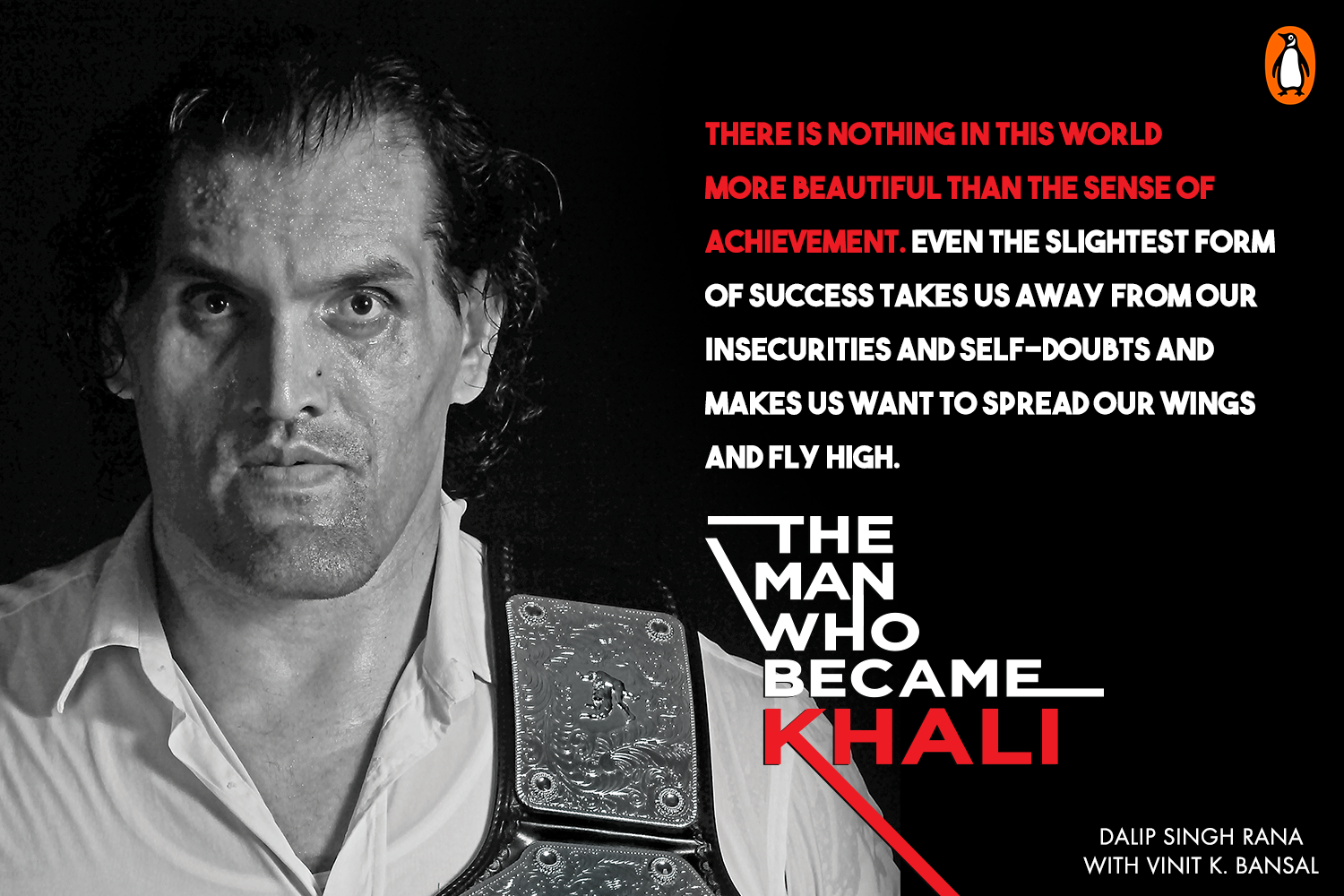
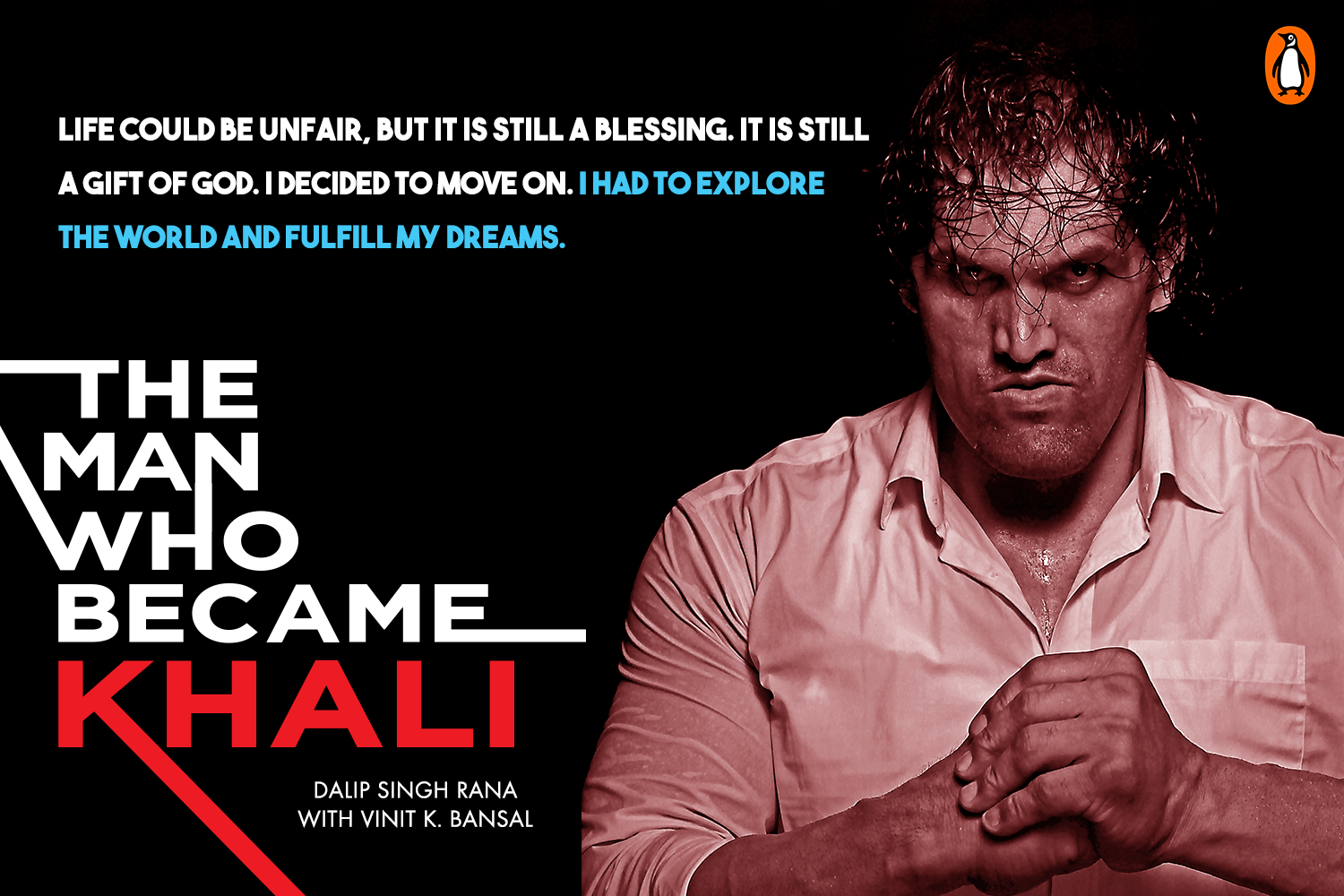

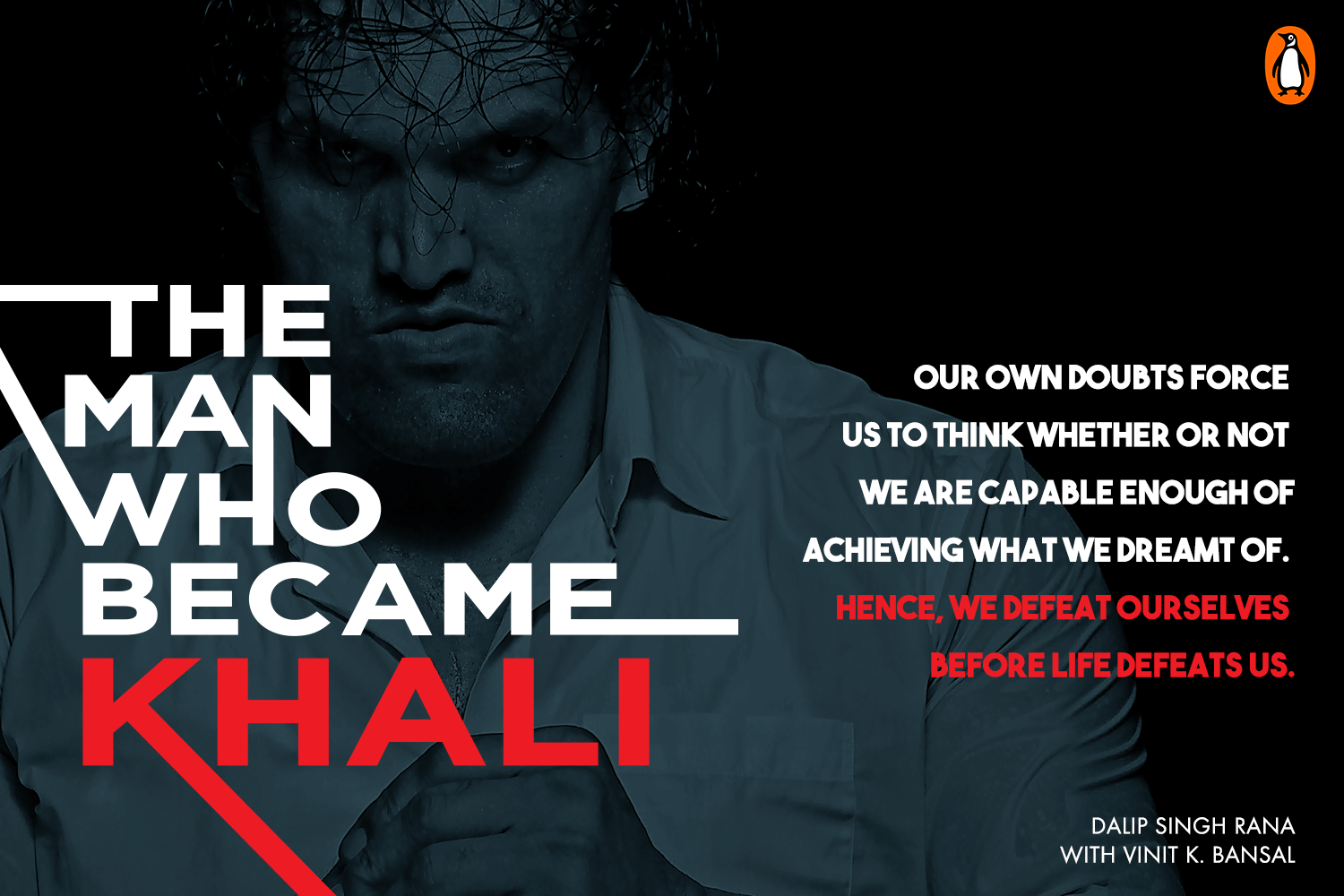
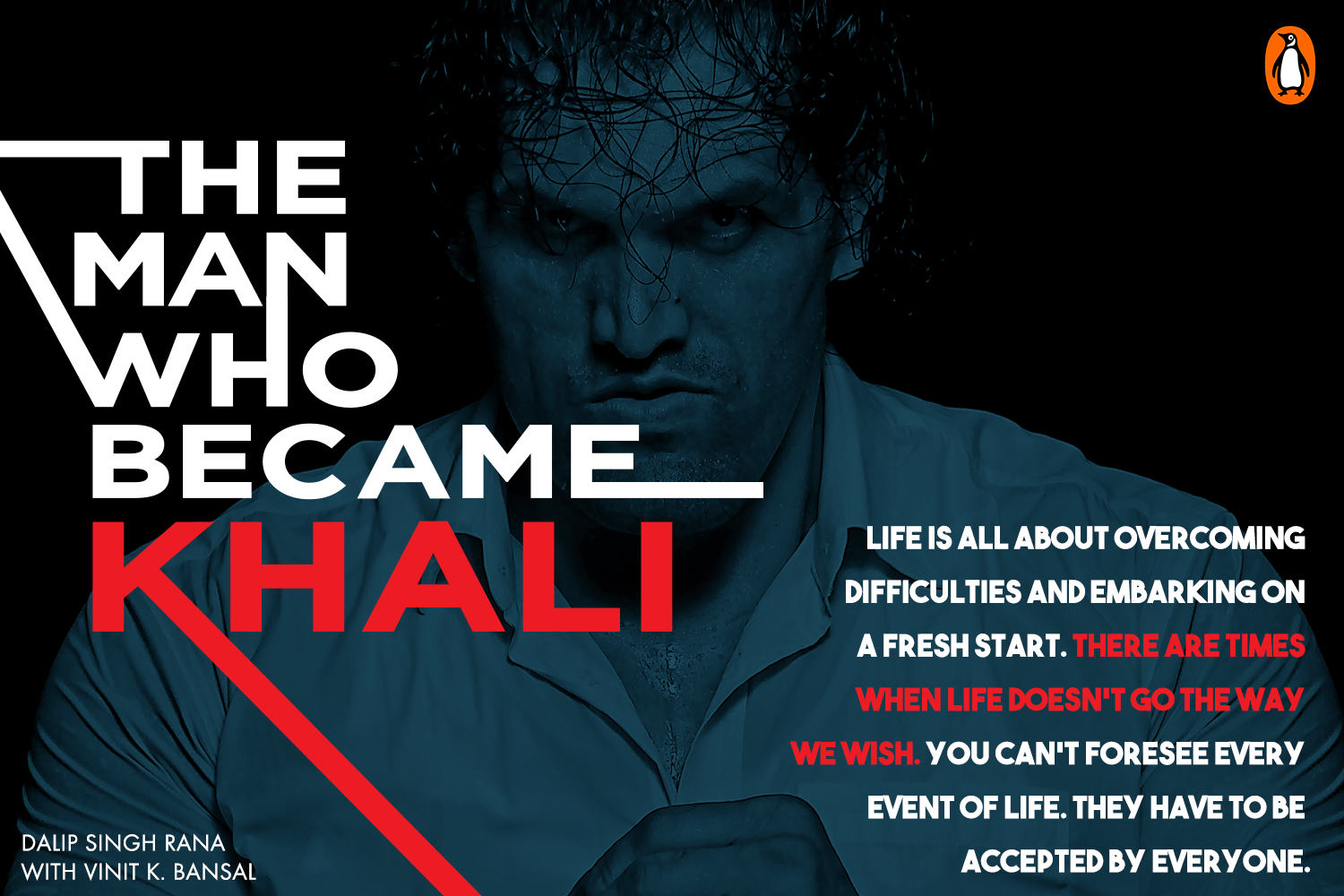
——–


















